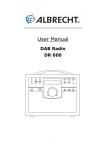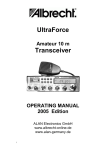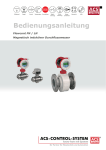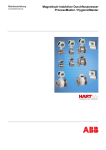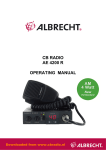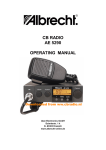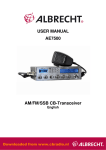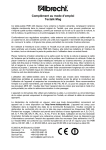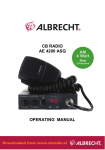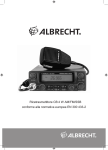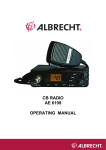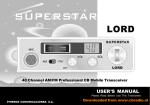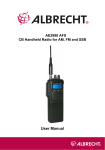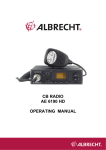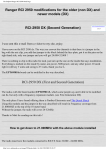Download www.cbradio.nl: Manual Albrecht AE497W Export Radio (ENG)
Transcript
User Manual AE 497 W (25-30 W-Version) 10-Meter Amateur Radio Base Station Downloaded from www.cbradio.nl Legal notes and general information This amateur radio base station complies to the minimum requirements of the EU directives 2004/108/EG (EMC), full fills the harmonized EU standards EN 301 783-2 (commercial available amateur radio products , EN 301 489-1 und-15 (EMC) und EN 60950-1:2006 (safety and LVD -directive 73/23/EWG) nad is marked with the CE logo. Following conditions apply: In all European countries this transceiver is subject to national amateur radio regulations. It may be used only by persons, who have obtained a valid amateur radio licence. Radio amateurs are only allowed to use this radio on assigned amateur radio frequencies within the 10 m band, even if this radio should be able to switch other adjacent frequencies. National regulations may exist for environmental RF protection and must be applied by the operator. It is not allowed to use this radio for any other purpose except amateur radio. If this radio shall be used in a configuration with other accessory items or amplifiers, the radio amateur is responsible to keep the radiations within the legal limits of his licence class, especially he has to follow the rules and standards of the above mentioned EU directive and technical standards, especially EN 301 783-2. It may be necessary to add separate harmonics filters when combining to amplifiers or SWR meters or antenna switching devices. This radio is not declared to be used in cars during motion, because we cannot declare that there is no possible influence on the electronic engine management. Please respect the automotive directive requirements, which request that such devices are not allowed to be connected to the car network as long as the car engine is running. These restrictions are only valid for passenger cars and trucks and do not apply to parking recreation vehicles, boats or other environments with 12 V power supply. ALAN ELECTRONICS GMBH The text of the English manual corresponds to international versions and is not in all parts equal to the German language user manual. 2 SPECIFICATIONS GENERAL Frequency Range …………………………………………………...28.000 to 29.699MHz Frequency Control ………………………………….Phase Lock Loop (PLL) synthesizer Frequency Stability………………………………………………………………… ± 300HZ Frequency Tolerance ………………………………………………………………0.0003% Emission Mode…………………………………………… A3E(AM), F3E(FM), J3E(SSB) Microphone ………………Electret type 6 pin plug, with PTT, up/down and coiled cord Input Voltage …………………………………13.8V DC nominal, 15,9V max. 12.0V min 230V AC Size (WDH)………………………………………………………………300 x 240 x 85mm Weight …………………………………………………………………………………..3,4Kg Antenna Connector…………………………………………. SO-239 50 ohm unbalanced Speaker……………………………………………………………………….8 ohm, 3 watts TRANSMITTER Power Output ……………………AM max. 7-8W, FM 25W-30 W, SSB 25W-30W PEP Spurious Emission …………………………………..……………….-36 dBm or – 60 dBc Current Drain No Modulation ……………………………………….FM/AM less than 4 A SSB …………………………………………………..…without modulation less than 1.0A Current Drain SSB with Modulation………………………………….SSB less than 4 A Modulation Frequency Response (1 KHz, 0dB Reference)……………………….....Lower, at 450Hz, AM -6dB, SSB -6dB Upper, at 2.5KHz, AM -6dB, SSB -6dB Microphone Sensitivity …………………………………………..AM 2.mV for 60% mod FM 1.8mV for 1.5 kHz deviation Microphone Amplifier ………………….AM 50dB (between 89% and 80% modulation) SSB 50dB (between 25 W PEP and 10W PEP) RECEIVER Max Sensitivity for 6dB S/N………………………………… AM 0.5uV, FM/SSB 0.25uV Sensitivity for 10dB S/N ……………………………………..AM 0.5uV, FM/SSB 0.25uV Overload Audio Fidelity at 6dB Down ………………………………….450Hz ~ 2000 Hz Adjacent Channel Selectivity …………………..………………FM/AM 60dB, SSB 70dB Image Rejection (5.6MHz) ……………………………………Typically better than 90 dB IF Rejection …………………………………………………………………..70dB or better Max Audio Output Power …………………………………………..AM/FM/SSB 2.5 watts Squelch Range……………………………………………..Adjustable from 0.5Uv to 1mV Receiver Clarifier Range…………………………………………….…±1.25KHz Variable Dynamic Range………………………………………………………………… 65dB (SSB) 3 Overview: Knobs and Keyboard functions 1 19 20 21 22 18 17 16 15 14 2 13 12 3 4 5 6 8 7 9 10 11 1. POWER ON/OFF SWITCH This switch turns the transceiver power on and off. 2. HEAD PHONE JACK Connect head phone plug, Impedance > 32 Ohms, Mono 3. MICROPHONE INPUT 6 pin socket for Albrecht Standard Electret Hand Microphone 4. VOLUME CONTROL Controls audio output level 5. SQUELCH CONTROL Used to quiet the receiver during absence of receive signals Sensitivity to incoming signals is fully adjustable 6. POWER CONTROL Fine adjusting of the Transmit Output Power, down to 3 W FM/SSB or 0.5 Watt AM 7. CLARIFIER CONTROL This control provides an adjustment for turning in stations which are slightly OFF frequency, to optimise the AM and SSB reception and transmission. 8. RF GAIN & MIC GAIN CONTROL Control the receiver sensitivity by RF GAIN CONTROL (outer knob) to reduce interference. To decrease RF gain, turn the knob counter clockwise. For the maximum receiver sensitivity, the RF GAIN control must be rotated clockwise. MIC GAIN CONTROL (inner knob) This control provides the proper or desired modulation. 9. CHANNEL SELECTOR SWITCH This Rotary switch selects the frequency steps. (Switch not active during transmission) 4 10. SWR CALIBRATION CONTROL The calibration control provides (while keying transmitter) meter calibration adjustment enabling true standing wave ratio reference. 11. CAL/ SWR/ MOD SELECTION This switch is used to select the scale to be read on the SWR/ Power Meter. The switch has three positions MOD (Modulation), CAL (Calibrate), SWR (Standing Wave Ratio) KEYBOARD switches 12 - 19 Some of these switches have a double or even 3 way functions. Pressing the FUNCTION knob (17) before lets You select the second function of the key. In some cases the third function is selected automatically depending on Your logical actions before. Primary function is indicated by “FUNCTION OFF:” This means no FUNC button shall be pressed Second function is indicated with “ FUNCTION ON: “ This means that You must press the FUNC button shortly before using the desired button. • Third function is always indicated in this way 12. MODE / LOW / MEMORY 5 SWITCH Double function button: without pressing FUNCTION before: MODE FUNCTION – select one of the operation modes FM / AM / USB / LSB • Load channel in the memory 5 with MEM switch. After pressing FUNCTION button before: LOW FUNCTON – This switch activates tone low (high cut) circuits. • Save channel in the 5 with MEM switch. 13. MEMORY SWITCH FUNCTION OFF: MEMORY LOAD FUNCTION – Load one of the 5 memory channels with 5 numeric key. FUNCTION ON: MEMORY SAVE FUNCTION – Save one of the 5 memory channels with 5 numeric key. 5 14. LCR / MEMORY 4 SWITCH FUNCTION OFF: LCR (Last Channel Recall) FUNCTION – Press LCR to return to the last channel that was used for longer than 3 seconds or was transmitted on. • Load channel in the memory 4 with MEM switch FUNCTION ON; • Save channel in the memory 4 with MEM switch 15. CALL / MEMORY 2 SWITCH FUNCTION OFF: CALL FUNCTION – This switch is used to access a reprogrammed frequency (memory 2) • Load channel in the memory 2 with MEM switch FUNCTION ON: • Save channel in the memory 2 with MEM switch 16. DIM SWITCH FUNCTION OFF: DIM FUNCTION – This switch is used to switch the instruments and keyboard illumination from bright to dimmer. 17. FUNC SWITCH BRIEF PUSH: This switch activates as FUNCTION switch the secondary function of double function switches. 18. STEP / NB / MEMORY 1 SWITCH FUNCTION OFF: STEP FUNCTION – This switch is used for select one of the frequency between: 1KHz / 10KHz / 100KHz 1KHz: 10KHz: 100 KHz: • steps Sets 1KHz digit of the desired operating frequency. Sets 10 KHz digit of the desired operating frequency. Sets 100KHz digit of the desired operating frequency. Load channel in the memory 1 with MEM switch. FUNCTION ON: NB FUNCTION – (Noise Blanker) If your reception is disturbed by interference from impulse type noise (ignition noise and other electrical noise press NB to reduce or eliminate the noise) • Save channel in the memory 1 with MEM switch. 6 19. SCAN / SHIFT / MEMORY 3 SWITCH FUNCTION OFF: SCAN FUNCTION – Set the scan mode on/off in RX mode. • Load channel in the memory 3 with MEM switch. FUNCTION ON: SHIFT FUNCTION for Repeater operation – Press the shift switch to select the direction: + SHIFT / -SHIFT. Press more than 3 seconds the SHIFT switch to select to off-set step: 0 ~ 990KHz. In most countries 100 kHz shift is usual. You can get more information by the local amateur radio clubs. • Save channel in the memory 3 with MEM switch. 20. LCD DISPLAY LCD indicates the frequency or channels if selected. 21. MOD / SWR ANALOG METER This meter reflects SWR calibration and modulation, operated in TX mode. 22. S / RF ANALOG METER In receive mode, this meter displays incoming signal strength. In the transmit mode this Meter displays RF power. BEEP/TONE Turning on power switch while keeping PTT key pressed sets beep mode on/off. Display Panel Features: Illustrated below are all the VISUAL INDICATORS that appear on the display, and the corresponding feature function that they associate with. Liquid Crystal Display Panel: The liquid crystal panel provides the user with a visual information on the operation and status of the AE 497 W. CAUTION: Due to the physical behaviour of LCD’s, liquid crystal displays should not be subjected to extremes of temperature or humidity. If the unit is exposed to temperatures below -20°C (-5°F) or above + 60°C ( +140°F), the display may temporarily cease to function properly, and in some cases, could result in permanent 7 damage. Do not subject radio to extreme conditions, such as closed automobile in direct sunlight or continuous sub zero temperatures. All liquid crystal displays have a preferred viewing angle when the display contrast is at a maximum. The best viewing point will vary by user, depending on such variables as temperature, humidity, battery condition, and the actual users eyesight. • Function ( FUNC) Mode: Indicates that the “FUNC” button has been selected, which allows for operation of many of the various features. • AM: Indicates AM mode operation. • FM: Indicates FM mode operation. • USB: Indicates Upper Sideband mode operation. • LSB: Indicates Lower Sideband mode operation. • SCAN: Indicates that the radio is in the “scan” mode which works in conjunction with all frequency and five memory locations. • Frequency Readout: Displays the corresponding frequency associated with the channel you are communicating with. • LOW: Indicates that the Tone Low feature has been turned on. • SHIFT: Indicates that the SHIFT (+ and -). • NB: Indicates that the Noise Blanker features has been turned on. • • “L”: Indicates that the memory recall ( = Load) mode has been activated “S”: Indicates that the radio is in the “Memory Store” mode, ready to receive a channel into one of the memory locations. • TX: Indicates that the radio is in the “transmit” mode. ANALOG INDICATOR METER: A A B S-TX METER: Indicates relative incoming signal strength and RF out put power. 8 B Modulation / SWR Meter: Measures the percent modulation of the AM signal. Note that the CAL/SWR/MOD switch must be in the “MOD” position for the meter to measure and read modulation. SWR METER: Measures the ratios of standing wave ratio of the antenna system, which is critical in properly adjusting the length antenna and all related electrical connections. This meter will indicate if there are any major changes in these critical areas caused by such things as humidity, vibration, or corrosion, which will cause the SWR Meter to rise. A rising SWR indicates that a problem exists. To Calibrate SWR: a) Set the radio into the AM mode. b) Switch the CAL/SWR/MOD knob to the SWR position c) Transmit by pressing the PTT button on the microphone, and adjust the SWR/CAL, control until the needle reaches the CAL position on the meter. d) Put the CAL/SWR/MOD knob back to the SWR position, and read the SWR value. INSTALLATION LOCATION OF THE RADIO Prior to beginning operation if the transceiver, a basic installation must be prepared. Installation of the transceiver itself is a rather simple procedure. In selecting the location for the unit, two basic factors must be considered: A. Access to 230V, 50Hz or 13,8V DC power source. B. The location must be convenient for running the antenna lead in cable if an outside antenna installation is proposed. BASE STATION ANTENNA Since the maximum allowable power output of the transmitter may be limited by the Regulations or Licence classes, the antenna is the most important factor affecting transmission distance. Only a properly matched antenna will allow maximum power transfer from the 50 ohm transmission line to the radiating element. The recommended method of antenna turning is to use the built in SWR meter to adjust the antenna turning for maximum reflected power. The radio may be used with any type of 50 ohm base station antenna. A ground plane vertical antenna will provide the most uniform horizontal coverage. This type of antenna is best suited for communication with a mobile unit. For point to point operation where both stations are fixed, a directional beam will usually increase communicating range since this beam antenna also allows the receiver to “listen” in only one direction, thus reducing interfering signals. 9 OPERATING PROCEDURES TO RECEIVE 1. Turn the radio ON by pressing the POWER switch. 2. Press the “Mode” selection button (labeled “5” on the button) continuously until you find the mode of operation you desire to operate in (AM, FM, USB, LSB). 3. Adjust the VOLUME control until you reach your desired listening level. 4. Turn the frequency selector knob to the desired operating frequency. 5. Turn the RF GAIN control completely clockwise. 6. Adjust the “CLARIFIER” control to clarify the SSB signals (start from middle position). 7. Listen to the background noise coming from the radio. Turn the squelch control slowly until the noise just disappears. (No signal should now be present). Leave the control at this setting. The SQUELCH is now properly adjusted. The receiver will remain quiet until a signal is actually received. Do not advance the knob too far, as some of the weaker signals will not be heard. OPERATING PRODEDURE TO TRANSMIT 1. Select the desired frequency of transmission. 2. Set the MIC GAIN control fully clockwise. 3. Activate the press to talk switch. The receiver and transmitter are controlled by the press to talk switch on the microphone. Press the switch and the transmitter is activated. Release the switch to receiver. 4. Hold the microphone two inches from your mouth, speak in a clear normal voice. 5. The S-TX meter will indicate power output and the modulation meter will indicate percentage of modulation as you speak into the microphone. CAUTION: Be sure the antenna is properly connected to the radio before transmitting. Transmitting without an antenna or a poorly matched antenna could cause damage to the transmitter. RESEIVING SSB SIGNALS There are four types of signals presently used for communications in the Citizen Band: AM, FM, USB and LSB. When the MODE switch on your unit is placed in the AM position, only standard double sideband, fully carrier signals will be detected. An SSB signal may be recognized while in the AM mode to produce an intelligible output. The USB and LSB modes will detect upper sideband an lower sideband respectively, and standard AM signals. 10 SSB reception differ from standard AM reception in that SSB receiver does not require a carrier or opposite sideband to produce an intelligible signal. A single sideband transmitted signal consists only of the upper or the lower sideband and no carrier is transmitter. The eliminate of the carrier from the AM signal helps to eliminate the biggest cause of whistles and tones heard on channels which make even moderately strong AM signals unreadable. Also, SSB take only half of an AM mode therefore two SSB conversations will fit into each frequency, expanding the two time frequency. The reduction in channel space required also helps in the receiver because only half of the noise and interference can be received with 100% of the SSB signal. An SSB signal may be received only when the listening receiver is functioning in the same mode. In other words, an Upper Sideband Signal (USB) may be made intelligible only if the receiver is functioning in the USB position. If a Lower Sideband (LSB) signal is heard when the receiver is in the USB mode, no amount of turning will make the signal intelligible. The reason for this may be understood if you consider that when the modulation is applied to the transmitter`s microphone in the USB mode, the transmitter`s output frequency is increased whereas in the LSB mode the transmitter’s output frequency is decreased. The result in listening to the receiver is that when the MODE switch is in the proper position (either USB or LSB), a true reproduction of single tone of modulation will result, and if the tone is increased in frequency (such as a low pitched whistle or a high pitched whistle) you will hear the increase in the output tone of the receiver. If the incorrect mode is selected, an increase in tone of a whistle applied to the transmitter will cause a decrease in the resultant tone from the receiver. Thus when a voice is used in place of a whistle or a tone, in the proper listening mode the voice will be translated backwards and cannot be made intelligible by the voice lock control. When listening to an AM transmission, a correct side band is heard in either mode since both upper and lower sideband are received. Once the desired SSB mode has been selected, frequency adjustment may be necessary in order to make the incoming signal intelligible. The CLARIFIER controls allow the operator to vary the frequency above and below the exact center frequency of the received signal. If the sound of the incoming signal is too high or too low pitched, adjust the CLARIFIER control. Consider it as performing the same function as a Dictaphone speed control. When the speed is set too high, voices will be high pitched, and if set too low, voices will be low pitched. Also, there is only one correct speed that will make a particular tape produce the same sound that was recorded. If the tape is played on a player that rotates in the wrong direction (opposite sideband), no amount of speed control (Clarifier) will produce an intelligible sound. An AM signal received while listening in one of the SSB modes will produce a steady tone (carrier) in addition to the intelligence, unless the SSB receiver is turned to exactly the same frequency by the Clarifier control. For simplicity it is recommended the AM modes be used to listen to AM signals. 11 Connectors for accessories Mic socket (3) 6 pin Standard plug, for Albrecht standard electret microphones with appr. 600 Ohm to1 kOhm Impedance: PIN 1 PIN 2 Mic Audio PTT-RX contact and Packet-Radio audio output PIN 3 PTT-TX contact PIN 4 UP- / DOWN keys PIN 5 Common ground, shielding Warning Notes: We have modified the mic wiring by end of 2008 to our Albrecht PIN 6 + supply voltage for mic preamplifiers Standard hand microphone with up/down key wiring. Please never connect any older microphone type with additional switches as they had been in use for former versions of this model (AE 497 S or AE 497WS or older versions of AE 485 S). The former additional key wiring may damage the PIN 6 power supply wiring inside the new radio model. Extension speaker socket (rear side) 3.5 mm Mono- socket for 4- 8 Ohm speakers with at least 2-4 Watt. Earphone socket (2) On the front panel You can find the PHONES socket. This is designed for MONO phones with 6.3 mm mono plug and standard impedances of 32 Ohms or higher. Stereo headphones can only be connected via adapter Stereo-to-Mono or must be equipped with a Mono 6.3 mm phones plug. It is not allowed to connect low impedance headphones ( with 8 Ohms or less), because EU regulations do not allow any more to use headphones and outputs where a risk of acoustical shocks may exists. Programming Modes For skilled service people we have provided a sub PCB inside of the radio which allows programming of several special channel configuration modes. Modifications are only allowed for use in countries where different modes are allowed. While it is allowed to sell amateur radios with the extended channel system + standard 10 m VFO mode in Germany (jumper position 2), some other European countries do not allow this and accept only the 10 m VFO range. In such cases the jumper must be plugged from position 2 into the position 1 by your distributor before sales. The reset button must be pressed after reprogramming. Repair & Service If any resending for repairs or warranty matters may become necessary for radios sold in Germany, please contact our hotline by phone. The Hotline will inform you about the nearest service address. Customers outside Germany should contact their local distributor. 12 Software procedure for Channel Mode (if enabled) : • • • Press FUNC and after this press „2/Call“ for longer than 3 seconds The radio works then in a channelized mode from 25.165 MHz to 29.695 MHz on 454 channels in 10 bands. Band switch: Press 2/Call Toggle between channel number and frequency display: • Press FUNC and then 2/CALL shortly. Frequency Range 28.000-29.699 MHz Frequenzmode 28.000-29.699 MHz Frequency Mode + 26.165- 29.695 MHz channel mode (454 channels) Function In some countries requested Enabled for sales in Germany. Switching via Function + 2/CALL (press 3 seconds) © Alan Electronics GmbH, 2010 – Daimlerstr. 1 k – D- 63303 Dreieich Technical Hotline: 01805 012204 (only for radios sold in Germany, 14 cents/minute, other charges from mobile networks) Customers in other countries please contact the local distributor or point of sale. Spare parts service: Fax : e-mail : Download-Server: 06103-9481-22 06103-9481-60 [email protected] www.hobbyradio.de 13 Declaration of Conformity We hereby declare that our product: 10 m Amateur Radio Transceiver AE 497 W satisfies all technical regulations applicable to the product within the scope of EU Council Directives and harmonized European Standards: EU- Directives : 73/23/EEC, 2004/108/EG and 99/5 EC ; European Standards EN 301 489-1 V 1.8.1, EN 301 489-15 V 1.2.1, EN 301 783-2 V.1.1.1, EN 60 950- 1 : 2006 All essential radio test suites have been carried out. Alan Electronics GmbH Daimlerstr. 1 k 63303 Dreieich GERMANY This declaration is issued under the sole responsibility of the manufacturer according to the procedure of Annex III R&TTE directive. Basing on this declaration, the amateur radio may be used only by authorized persons having a valid amateur radio licence, and only for the purpose of amateur radio service in the dedicated frequency ranges. Note: the latest valid issue of this Declaration of Conformity, as well as all other information about this radio and possible restrictions of use, can be downloaded any time from our public internet server under: http://www.hobbyradio.de Contact person: Wolfgang Schnorrenberg Place and date of issue: Lütjensee, den 22. 12. 2009 (Signature) Dipl.-Phys. Wolfgang Schnorrenberg Alan Electronics GmbH 14 Channel number 1 2 3 3A 4 5 6 7 7A 8 9 10 11 11A 12 13 14 15 15A 16 17 18 19 19A 20 21 22 23 24 25 26 27 28 29 30 31 32 33 34 35 36 37 38 39 40 41 42 43 44 25.615 25.625 25.635 25.645 25.655 25.665 25.675 25.685 25.695 25.705 25.715 25.725 25.735 25.745 25.755 25.765 25.775 25.785 25.795 25.805 25.815 25.825 25.835 25.845 25.855 25.865 25.875 25.905 25.885 25.895 25.915 25.925 25.935 25.945 25.955 25.965 25.975 25.985 25.995 26.005 26.015 26.025 26.035 26.045 26.055 25.165 25.185 25.195 25.205 25.215 25. 225 25. 235 25.245 25. 255 25. 265 25.275 25.285 25.295 25.305 25.315 25.325 25.335 25.345 25.355 25.365 25.375 25.385 25.395 25.405 25.415 25.425 25.455 25.435 25.445 25.465 25.475 25.485 25.495 25.505 25.515 25.525 25.535 25.545 25.555 25.565 25.575 25.585 25.595 25.605 B A 26.065 26.075 26.085 26.095 26.105 26.115 26.125 26.135 26.145 26.155 26.165 26.175 26.185 26.195 26.205 26.215 26.225 26.235 26.245 26.255 26.265 26.275 26.285 26.295 26.305 26.315 26.325 26.355 26.335 26.345 26.365 26.375 26.385 26.395 26.405 26.415 26.425 26.435 26.445 26.455 26.465 26.475 26.485 26.495 26.505 C 26.515 26.525 26.535 26.545 26.555 26.565 26.575 26.585 26.595 26.605 26.615 26.625 26.635 26.645 26.655 26.665 26.675 26.685 26.695 26.705 26.715 26.725 26.735 26.745 26.755 26.765 26.775 26.805 26.785 26.795 26.815 26.825 26.835 26.845 26.855 26.865 26.875 26.885 26.895 26.905 26.915 26.925 26.935 26.945 26.955 D 26.965 26.975 26.985 26.995 27.005 27.015 27.025 27.035 27.045 27.055 27.065 27.075 27.085 27.095 27.105 27.115 27.125 27.135 27.145 27.155 27.165 27.175 27.185 27.195 27.205 27.215 27.225 27.255 27.235 27.245 27.265 27.275 27.285 27.295 27.305 27.315 27.325 27.335 27.345 27.355 27.365 27.375 27.385 27.395 27.405 E 15 27.415 27.425 27.435 27.445 27.455 27.465 27.475 27.485 27.495 27.505 27.515 27.525 27.535 27.545 27.555 27.565 27.575 27.585 27.595 27.605 27.615 27.625 27.635 27.645 27.655 27.665 27.675 27.705 27.685 27.695 27.715 27.725 27.735 27.745 27.755 27.765 27.775 27.785 27.795 27.805 27.815 27.825 27.835 27.845 27.855 F 27.865 27.875 27.885 27.895 27.905 27.915 27.925 27.935 27.945 27.955 27.965 27.975 27.985 27.995 28.005 28.015 28.025 28.035 28.045 28.055 28.065 28.075 28.085 28.095 28.105 28.115 28.125 28.155 28.135 28.145 28.165 28.175 28.185 28.195 28.205 28.215 28.225 28.235 28.245 28.255 28.265 28.275 28.285 28.295 28.305 G 28.315 28.325 28.335 28.345 28.355 28.365 28.375 28.385 28.395 28.405 28.415 28.425 28.435 28.445 28.455 28.465 28.475 28.485 28.495 28.505 28.515 28.525 28.535 28.545 28.555 28.565 28.575 28.605 28.585 28.595 28.615 28.625 28.635 28.645 28.655 28.665 28.675 28.685 28.695 28.705 28.715 28.725 28.735 28.745 28.755 H Frequency table for AE 497W (only for activated channel-mode) 28.765 28.775 28.785 28.795 28.805 28.815 28.825 28.835 28.845 28.855 28.865 28.875 28.885 28.895 28.905 28.915 28.925 28.935 28.945 28.955 28.965 28.975 28.985 28.995 29.005 29.015 29.025 29.055 29.035 29.045 29.065 29.075 29.085 29.095 29.105 29.115 29.125 29.135 29.145 29.155 29.165 29.175 29.185 29.195 29.205 I 29.215 29.225 29.235 29.245 29.255 29.265 29.275 29.285 29.295 29.305 29.315 29.325 29.335 29.345 29.355 29.365 29.375 29.385 29.395 29.405 29.415 29.425 29.435 29.445 29.455 29.465 29.475 29.505 29.485 29.495 29.515 29.525 29.535 29.545 29.555 29.565 29.575 29.585 29.595 29.605 29.615 29.625 29.635 29.645 29.655 29.665 29.675 29.685 29.695 J
















